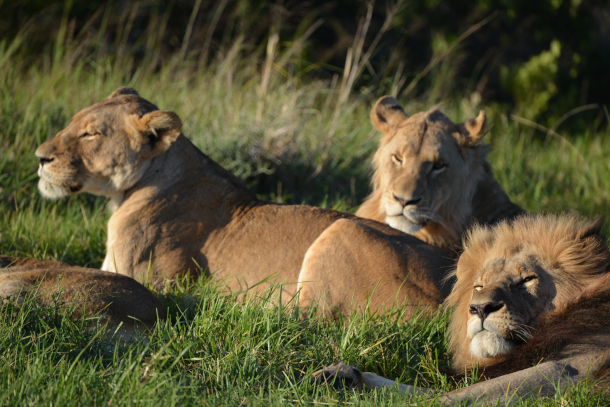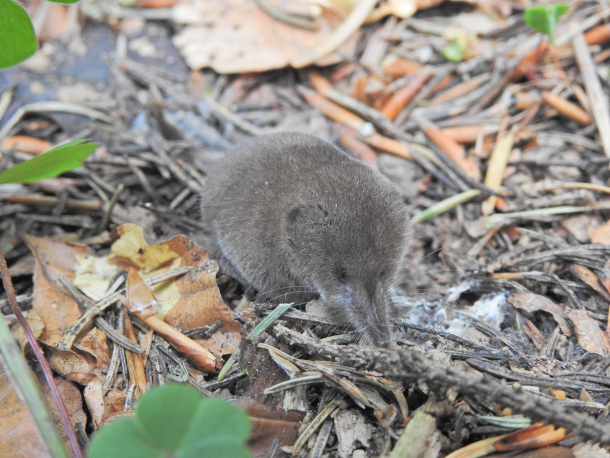Note on Emerging Science: Social Mammal Longevity
Air Date: Week of October 13, 2023

Lions form social groups known as ‘prides’. (Photo: SenatorCMP, Flickr, CC BY-NC-ND 2.0)
A recent study found that mammals that live in groups tend to live longer than solitary mammal species, even after accounting for other factors. Living on Earth’s Don Lyman explains why being social appears to benefit members of a group and help them live longer.
Transcript
BELTRAN: It’s Living on Earth, I’m Paloma Beltran.
DOERING: And I’m Jenni Doering.
So Paloma, last week we mentioned that voting for Fat Bear Week was underway and we now have a winner!
BELTRAN: Ooh! Who won this year?
DOERING: Fans crowned 128 Grazer as the champion. She’s a mom to five cubs and almost 20 years old.
BELTRAN: Congrats to Grazer! Sounds like she’s ready to survive the long winter. Now on to some mammals who are even more long-lived in this note on emerging science from Don Lyman.
[SCIENCE NOTE THEME]
LYMAN: Maximum lifespans of mammals range from about two years for some shrew species to upwards of 200 years for bowhead whales. But researchers who analyzed the lifespans and sociality of over 900 species of mammals, recently reported that species that live in groups, like horses and chimpanzees, tend to live longer than solitary species, like weasels and hedgehogs. Evolutionary biologists from the Chinese Academy of Sciences in Beijing analyzed information from the scientific literature on the social organization of the 974 mammal species by dividing them into three categories: solitary, pair-living, and group-living. The researchers then compared the three categories with data on the mammal species’ longevity. They discovered that the mammals that lived in groups tended to live an average of 22 years, while the solitary mammal species lived about 12 years.

Shrews are solitary mammals. (Photo: Xulescu_g, Flickr, CC BY-SA 2.0)
Bigger mammals generally live longer than smaller species, so the researchers then accounted for body mass, but they found that the effect of sociality still conferred longer lifespans. One example was that of similarly small shrews and bats. The scientists found that the solitary shrews lived only a few years, while some social bat species lived 30 or 40 years.
The researchers were surprised by their findings, because individuals that live in groups face potential costs, such as competition for mates and for food, as well as the spread of infectious diseases. But the scientists also noted the benefits of living in a group, such as protection against predators, as well as group foraging for food which might decrease the chance of starvation. These benefits might increase the length of social mammals’ lives.
The researchers also speculated that the evolution of long lives might be more likely in species that live in groups because the group members might aid the survival of their family members, which carry their genes.
That’s this week’s note on emerging science. I’m Don Lyman.
Links
Living on Earth wants to hear from you!
Living on Earth
62 Calef Highway, Suite 212
Lee, NH 03861
Telephone: 617-287-4121
E-mail: comments@loe.org
Newsletter [Click here]
Donate to Living on Earth!
Living on Earth is an independent media program and relies entirely on contributions from listeners and institutions supporting public service. Please donate now to preserve an independent environmental voice.
NewsletterLiving on Earth offers a weekly delivery of the show's rundown to your mailbox. Sign up for our newsletter today!
 Sailors For The Sea: Be the change you want to sea.
Sailors For The Sea: Be the change you want to sea.
 The Grantham Foundation for the Protection of the Environment: Committed to protecting and improving the health of the global environment.
The Grantham Foundation for the Protection of the Environment: Committed to protecting and improving the health of the global environment.
 Contribute to Living on Earth and receive, as our gift to you, an archival print of one of Mark Seth Lender's extraordinary wildlife photographs. Follow the link to see Mark's current collection of photographs.
Contribute to Living on Earth and receive, as our gift to you, an archival print of one of Mark Seth Lender's extraordinary wildlife photographs. Follow the link to see Mark's current collection of photographs.
 Buy a signed copy of Mark Seth Lender's book Smeagull the Seagull & support Living on Earth
Buy a signed copy of Mark Seth Lender's book Smeagull the Seagull & support Living on Earth

